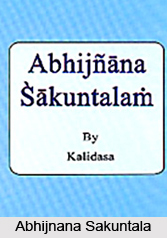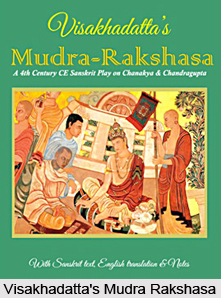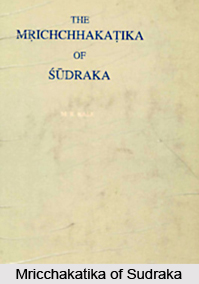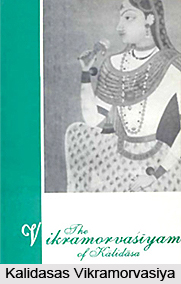 Sanskrit theatre is inseparably related to the origin of Indian theatre. It also draws heavily from the Sanskrit literary tradition. The dramatists of Sanskrit theatre worked on pre-existing mythological or historical themes that were well-known among the audience of that age. Bharata`s Natyashastra is a keystone work in Sanskrit literature on the subject matter of stagecraft.
Sanskrit theatre is inseparably related to the origin of Indian theatre. It also draws heavily from the Sanskrit literary tradition. The dramatists of Sanskrit theatre worked on pre-existing mythological or historical themes that were well-known among the audience of that age. Bharata`s Natyashastra is a keystone work in Sanskrit literature on the subject matter of stagecraft.
Origin of Sanskrit Theatre
Sanskrit theatre originated with the influx of Indian theatre. Indian myth confirms that dharma prevailed in Satyayuga. In that period people were ignorant of pain and sorrow. In tretayuga which is the silver age, dharma weakened and suffering arose in the lives of the people. The gods, worried about human welfare, approached Lord Brahma, the Creator, under the leadership of Lord Indra and prayed to him to produce an object of sport i.e. kridaniyaka to give pleasure to people`s eyes and ears. Brahma took recourse to yoga, selected the text from the Rig Veda, song and music from the Sama Veda, acting from the Yajur Veda, and aesthetic sentiment from the Atharva Veda to create a fifth Veda known as the natyaveda i.e. `theatre knowledge`. The Natyaveda of Brahma was given to Bharata to make it known to the mankind. Bharata with his troupe of gandharvas and apsaras performed natya, nritta, and nritya before Lord Shiva. From the hands of gods the art form was passed on to the mortals.
Sanskrit Theatre as a Part of Literary Tradition
Recitation of the epics, gatha, and narasamsi i.e. legends honouring great men and women had a long continuity and popularity, attested in literature. Sutas, kusilavas, and gathakas comprised the community of reciters. Patanjali`s Mahabhashya i.e. `Great Discourse` mentions a powerful tradition of granthikas and sobhanikas. They not only recited the legends of binding Bali and killing Kamsa, but enacted them too. Critics view this as a reference to mime. The Sitabenga cave inscriptions suggest public poetic or dramatic presentations by the second century BC. The subjects of recitative and histrionic performances, like Krishna`s exploits mentioned in the Mahabhashya and Harivamsa i.e. `Hari`s Dynasty` indicate the religious nature of Sanskrit theatre. The close connection of religion with performance still survives in the innumerable forms of temple theatre scattered throughout India.
 Sanskrit playwrights
Sanskrit playwrights
The earliest available Sanskrit plays are the thirteen ascribed to Bhasa. None of them states explicitly either in the prologue or the colophon. These are the usual conventions in Sanskrit drama. These are Bhasa`s work. In fact, their discovery and attribution to him at the beginning of the twentieth century created a controversy. However, striking thematic and technical similarities in them and the certain identification of Swapna-Vasavadatta i.e. `Vasavadatta in the Dream` with Bhasa, established their authorship. The plays embrace tales derived from the Ramayana, the Mahabharata, Krishna lore, popular history, and love stories. They are marked by significant possibilities of performatory elaboration, as evident to this day from their presence in the traditional repertoire of Kutiyattam. Kalidasa was the greatest Indian dramatist. He drew inspiration from Bhasa, but himself became the paramount influence on future generations. Regarded as the supreme poet of love with the highest possible refinement and insight, he attained the culmination of genius in the world-renowned Abhijnana-Sakuntala. If Bhasa sometimes appears to rebel against the conventions lay down by Bharata, Kalidasa offers the model of the Natyashastric tradition of playwriting.
Elements of Sanskrit theatre
Sanskrit drama was divided into rupakas and uparupakas. Rupakas are the ten major forms, and uparupakas are the minor forms. The rupakas comprised nataka, samavakam,vyayoga, dima, ihamriga, utsrishtikamka, prakarana, prahasana, bhana, and vithi. Their plots were broadly classified as those known from tradition, which the playwright derived from myths, legends, and history, or as those newly created by his imagination. The former category included nataka, samavakara, vyayoga, dima, and ihamriga; in the latter figured prakarana, prahasana, and bhana. Utsrishtikamka sometimes was sourced from tradition, sometimes from invention. Vithi was a class in itself, and many forms took elements from it. Uparupaka forms included the natika and sattaka. Vrittis also played an important role in determining the structure of Sanskrit drama.
Sanskrit theatre stressed the delineation or portrayal of bhava i.e. emotive state. Performers evoked to the audience these bhavas which, through powerful abhinaya or acting were transformed into the ideal, central aesthetic experience of rasa.
 The Natyashastra also laid down two modes of theatrical representation. The first, lokadharmi, was nearer to the way things are seen in ordinary life. The second i.e. natyadharmi was more conventional. However, a dialogue between them always existed. They were not completely opposite modes, but shared some complementarities. Lokadharmi may be seen as having survived in innumerable Indian folk forms, whereas natyadharmi is viewed in classical dance or dance-drama. The linguistic structure of Sanskrit drama is also very significant, as well as the highly refined theory of dhvani, or literary suggestion. From the very beginning, its multilingualism provided a unique theatricality. The simultaneous presence of Sanskrit, the commoners` Prakrit, and even Apabhramsa infused textual strength. This feature survives in Kutiyattam, where the vidushaka elaborates his Prakrit dialogue into Malayalam, which is a modern Indian language.
The Natyashastra also laid down two modes of theatrical representation. The first, lokadharmi, was nearer to the way things are seen in ordinary life. The second i.e. natyadharmi was more conventional. However, a dialogue between them always existed. They were not completely opposite modes, but shared some complementarities. Lokadharmi may be seen as having survived in innumerable Indian folk forms, whereas natyadharmi is viewed in classical dance or dance-drama. The linguistic structure of Sanskrit drama is also very significant, as well as the highly refined theory of dhvani, or literary suggestion. From the very beginning, its multilingualism provided a unique theatricality. The simultaneous presence of Sanskrit, the commoners` Prakrit, and even Apabhramsa infused textual strength. This feature survives in Kutiyattam, where the vidushaka elaborates his Prakrit dialogue into Malayalam, which is a modern Indian language.
Music was an integral part of theatre. This becomes prominent in order to provide pleasure in the recitation of the text. Bharata, Kalidasa, and some later dramatists speak of the employment of dhruva songs. Certainly, musical integration began with the introduction oigita or song and atodya or music. This served not only to determine the pace and rhythm of movement, gait, exits, and entrances, but also to incorporate lasyangas into the play. The change in Sanskrit theatre from rupakas to uparupakas is marked by the increasing use of music. The tendency was already present in the period of Kalidasa and Harivamsa, and gathered momentum with the passage of time. Music became more essential and uparupakas were often called sangitakas i.e. `song works`. Dance, too, acquired a more dominant place in the dramatic and theatrical structure. References in Abhinavagupta`s Abhinavabharati, Saradatanaya`s Bhavaprakasana and other texts verify this conclusion. The connection between `folk` forms and Sanskrit performance is also old. The detailed stage direction in Kalidasa`s Vikramorvasiya i.e. `Urvasi Won by Valour` was a unique play from this point of view. This reveals extensive employment of music and dance in production. Many of the terms are not traceable either to the Natyashastra or later treatises. They appear to have been taken from the popular theatre of the early medieval age, and prove that Kalidasa`s script had an unbroken tradition of performance up to that period.
Influence on Sanskrit theatre
Asvaghosha, a Buddhist author adorning the court of Kanishka represents another ideology in Sanskrit drama. From available fragments of his work, it can be gathered that his subject matter was conversion to Buddhism. Sudraka in Mricchakatika achieves astonishing heights of treatment given to contemporary social realities. His vibrant masterpiece offers a refreshing and subversive notion of love between a generous but poor Brahman and a delicate courtesan inspired by romantic ideals. In the background a cruel ruler, the struggling common people, the air of revolt, gamblers, monks, helpless judiciary, and prevailing fraud can be seen. On the other hand, Visakhadatta derived material from history in Mudra-Rakshasa i.e. `Rakshasa`s Signet Ring`.
 This is an unusual play of political intrigue between Chandragupta Maurya`s minister Kautilya and Rakshasa i.e. the minister of the ousted king. The three plays of Harsha have been said to reveal Buddhist compassion and introduce models of romantic drama neatly structured in keeping with the plot technique taught in the Natyashastra. In addition, traces of folk music and dance in his Ratnavali mark the beginning of a new era in Sanskrit theatre. Bhatta Narayana develops the tragic character of Asvatthama in Venisamhara i.e. `Tying of the Braid`. This was based on the story in the Mahabharata. The powerful Bhavabhuti during seventh to eighth century is often considered Kalidasa`s equal, and his play Uttara-Ramacarita i.e. `Rama`s Later Exploits` also contains strong evocation of karuna rasa or pathos. Replete with epic qualities, it presents life in diverse dimensions.
This is an unusual play of political intrigue between Chandragupta Maurya`s minister Kautilya and Rakshasa i.e. the minister of the ousted king. The three plays of Harsha have been said to reveal Buddhist compassion and introduce models of romantic drama neatly structured in keeping with the plot technique taught in the Natyashastra. In addition, traces of folk music and dance in his Ratnavali mark the beginning of a new era in Sanskrit theatre. Bhatta Narayana develops the tragic character of Asvatthama in Venisamhara i.e. `Tying of the Braid`. This was based on the story in the Mahabharata. The powerful Bhavabhuti during seventh to eighth century is often considered Kalidasa`s equal, and his play Uttara-Ramacarita i.e. `Rama`s Later Exploits` also contains strong evocation of karuna rasa or pathos. Replete with epic qualities, it presents life in diverse dimensions.
Sanskrit theatre was holistic, consisting of a highly evolved text, pre-written as well as orally circulating among the community of artists. The rediscovery of the Natyashastra and Bhasa excited scholars and artists in Sanskrit dramatic performance, nearly extinct in the twentieth century. The search for an identity in Indian theatre after Independence also resulted in a serious inquiry into both traditional forms and classical Sanskrit sources. As a result, revivals of Sanskrit plays took place under directors like K. N. Panikkar and actors like Daji Bhatawadekar.




